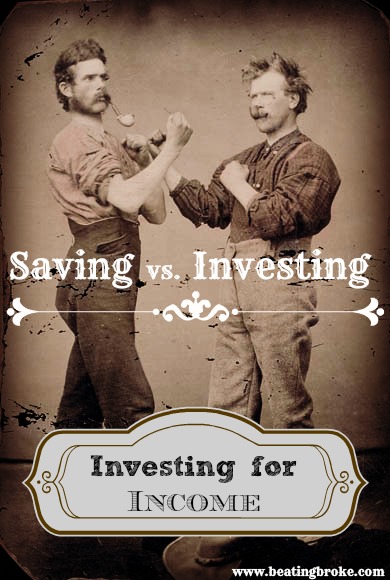Saving and investing go together like milk and cookies, sweet and sour, and Elvis and banana peanut butter sandwiches, right? Right. Well, almost right. It’s easy for us to say that saving and investing are important parts of a personal finance plan. It’s easy for us to say that and then move on. After all, we just said they’re important, right? Not so fast.
Saving and Investing ARE important
They just aren’t equally important. Heck, it’s another whole post, but even the different types of investing aren’t equal. Just as important as saving and investing together is the concept of when to use which, and how much. The mix of liquid savings in the form of cash accounts and CDs with the amount of your money that’s invested can be one of the most important parts of your overall personal finance plan.
Traditional advice tells us that cash accounts and CDs are the super safe way to keep your money with you, and investing, in it’s varying forms is all kinds of risky. Investing in stocks? Risky. Investing in pork bellies? Risky. (unless you really like bacon. Just kidding, still risky.) But, is the amount of risk involved in investing more or less risky than leaving too much of your money in the bank to rot away at current interest rates? How about you ask the people of Cyprus if they still feel safe having their money in the bank?
 Success is risky.
Success is risky.
Few who accomplish success do so without some element of risk. In fact, the easier the path to success is perceived, the less chance there is of truly obtaining it. I don’t say that to seem philosophical. I want to make a point, however. You’ve got to have a little risk, if you want to succeed. You’ve got to have Investments if you want to succeed financially. And, I think the ratio of investments to savings should probably be much higher than most would suggest.
Investing for Financial Independence
One of the key tenets in a financial independence plan is that you need to replace your income in order to free yourself up to be independent of a job. Not independent of work, but of a job. There are, obviously, many ways that you can go about replacing that income. Decreasing your expenses is usually a part of most plans. But, most people’s expenses will only decrease so far. Sure, you can go extreme, and get them lower, but for many that isn’t what financial independence is about. Even with your expenses decreased as low as you’re willing to take them, you’ve still got to replace the income to pay those expenses. Investing can be a very good way to get started towards replacing your income.
Investing for Income
In order to replace income with investing, you’ve got to invest for income. You probably try and do that by becoming a super successful day trader and making up the income in profits from all the great deals you made. First, find yourself a few super successful day traders who have done that. Come back when you’ve given up. If you’re going to invest for income, it’s got to be reliable. It can’t rely on your ability to find a good bargain and then sell it at a massive profit a few days later. There are traders who are still waiting on Facebook to make a comeback so they can even get their money back. Reliable income is the key. For this, we need investments that are steady, don’t require the continued increase in value of the stock, and also don’t require us to sell like a fiend in order to create the income. What are these mysterious investments, you ask? Dividend stocks.
Dividend stocks are stocks that pay a dividend on each share of the stock that is held. The amount of the dividend can vary, but there are many that you will find that pay dividends in the range of 2-4%. Depending on the policy of the company, they usually pay quarterly, but there are some that pay monthly and yearly.
Dividend stocks aren’t the only way to invest for income, however. Investing in peer-to-peer lending in a program like Lending Club is one. Rental real estate is another. A business can even be a way to invest for income. Each has varying levels of passivity, or the amount of direct interaction on your part to earn the income. A business that you run can mean well over 40 hours a week of direct interaction to create the income. Something like Lending Club or rental real estate can be brought down to a level that borders on passive income entirely.
Savings vs. Investing
With any investing tool, whether it be dividend stocks, lending, real estate, or some other instrument, there will be risk. With risk usually comes reward. I’ve been earning over 8% return on my Lending Club portfolio. Dividend stocks can lose value, or even stop paying dividends. The real estate market can dry up, and you can have problems finding renters. Risk is inherent. Unless you want to directly trade your time for money (call it a job), you’ve got to take on a little risk and begin setting yourself free.
Savings shouldn’t be shunned completely. I still believe that an emergency fund is an important tool. I still covet a debt free lifestyle. But, once my debt is paid off, and my emergency fund is full, you can bet the rest will go towards investing for income, and building my wealth towards financial independence.
How about you? What is the role of savings in your personal finance journey?
Original img credit: Two men with pipes posing as boxers / Deux hommes, pipes à la bouche, prenant une pose de boxeur by BiblioArchives / LibraryArchives, on Flickr

I started this blog to share what I know and what I was learning about personal finance. Along the way I’ve met and found many blogging friends. Please feel free to connect with me on the Beating Broke accounts: Twitter and Facebook.
You can also connect with me personally at Novelnaut, Thatedeguy, Shane Ede, and my personal Twitter.


